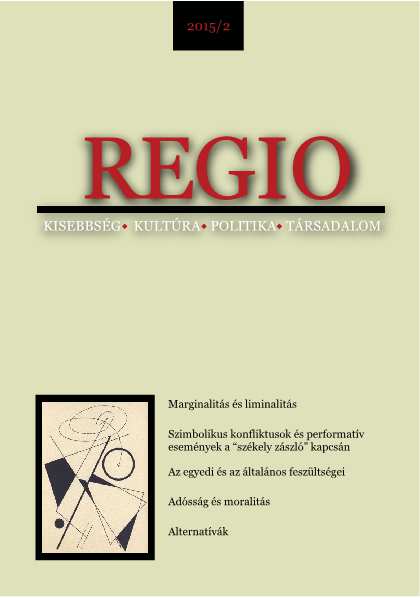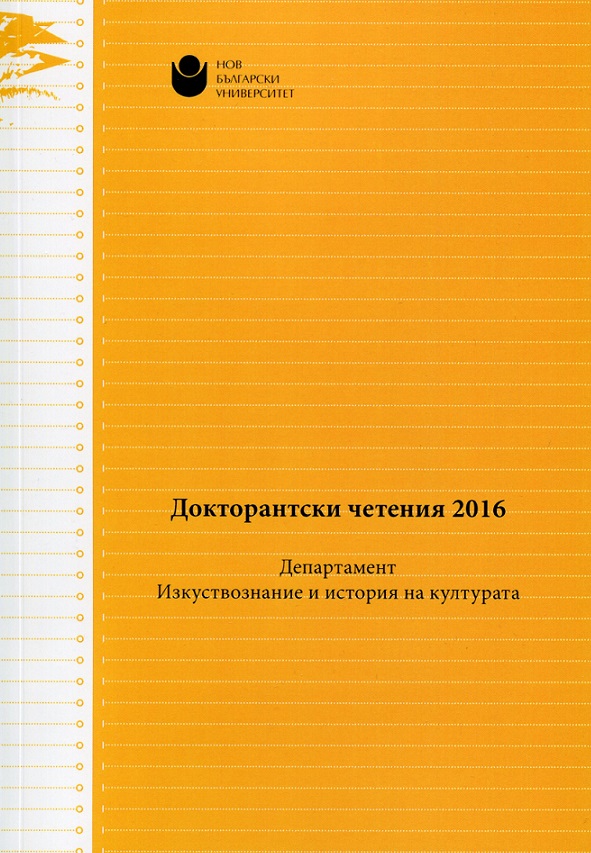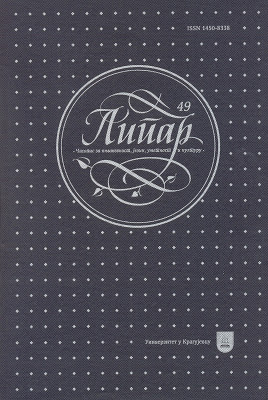
We kindly inform you that, as long as the subject affiliation of our 300.000+ articles is in progress, you might get unsufficient or no results on your third level or second level search. In this case, please broaden your search criteria.


The book and the TV… Even the simple juxtaposition of these two symbolic entities has triggered multiple discussions and almost all the critiques and reviews have targeted the small screen: that it favors electronic reading, eliminating the fundamental books from the man’s short lifespan ... It is a big and, probably, unsolvable problem. Perhaps it is time to surpass the purist vision of culture, by approaching the book/TV rapport not as an exclusive relationship – one or the other, but as a form which allows alternatives – one and the other. In our age, when TV and new media have turned the cultural space upside down, literature, as a classical form of art, must diversify its strategies used in reaching the public, audiovisual channels included. The prologue of the study evokes a series of literary-artistic formulas through which the book universe appears in a number of audiovisual versions. What follows is the analysis of the possibilities which allow to capitalize the book in the TV series film. The last section is focused on a problem with many variables: is the TV series film a center of interest for the studious youth?
More...


The article draws the attention towards the peculiarities of the highly aesthetical character in the animated film, which unlike its way of expression in painting, printmaking and sculpture possesses a fourth dimension – it acts in time. The article explores the main principles in the creation of the character, some of which are inextricably linked to the dramaturgy of the film. An emphasis is put on the dynamic function of its design, which finds its true fulfillment in the movement. Another contribution provided through the article is a detailed constructive analysis of the separate components of the animated character, which besides being the bearers of its specific features are required to provide its great functionality too. A new categorization is implied, which not only facilitates, but also contributes to a deeper study of the contemporary animated character.
More...
Blos-Jáni Melinda: A családi filmezés genealógiája. Erdélyi amatőr médiagyakorlatok a fotózástól az új médiafajtákig
More...


Actress and singer, Katalin Karády was the time's celebrated star between 1939 and 1944 in Hungary. That is why she is considered to be a defining symbol of the first half of the 20th century. Karády was the first example of star culture in Hungary; the kind of selfmade woman who climbed the social ladder in an impressive way. The questions that this study aspires to seek answers to may be manifested in the way Karády's public persona was schematized in the Hungarian press between WWI and WWII, falling back on an empirical research method. Using representation and star theories, the study also seeks to unveil the depths of Karády's life, and places focus on press articles discussing her lifestyle using the following question as a starting point: just what picture could have been painted of her in the press between the two world wars, and what effect could she have had on the fashion of the era?
More...
The starting point of this paper is the fact that each field seen on the screen as present is counterbalanced with its echo absent field, outside of the boundaries of the frame that the spectator can only sew, fill in or stitch (film suture) to the existing one, which is called off-screen space or imaginary field of the film picture. Due to this fact the action taking place beyond the boundaries of the silver screen, the one that is not seen, can be a lot more exciting than the visible one. One of the basic presumptions of this paper is that the imaginary field of the film picture, i.e. the offscreen space is always present, even without its visual, sound or narrative indication, because of its receptive and aesthetic models of operation. These models condition viewers to constantly recapitulate the events they have seen and heard during film thus creating a mosaic of information and looking for their narrative, aesthetic of psychological connections. This process is influenced by the look of film spectator which starts complex processes of perception and aperception which are an integral part of the reception process, which then initiates the process of reading and interpreting film, but also the pocess of aesthetical knowledge and cultural heritage. That is way this paper analyzes possible models of construction of the film image on the levels of perception, aperception and reception
More...
The aim of this paper is to explore the elements of Gothic fiction in the critically acclaimed Spanish director Pedro Almodóvar’s 2011 film The Skin I Live In. The film is often viewed as a distinctly modern piece of art in that it dwells on contemporary issues referring to complex ethical and moral dilemmas connected to genetic engineering and the disintegration of an individual’s identity. However, despite the undeniable presence of the said issues, the idea is to show that the film’s structure is in fact solidly built on a much older Gothic fiction matrix featuring many of its well-established, easily discernible motifs and conventions. Starting with the classic Gothic topos – a helpless heroine set in an eerie, claustrophobic architecture, and a grotesque atmosphere evoking a feeling of imminent doom – the paper will consider the film’s portrayal of concepts such as death, doubles, and dreams in order to show that the work of the Spanish director bears many similarities to the canonical Anglophone genre. Inevitably, the analysis will also examine the distinct parallel between Mary Shelley’s seminal Gothic fiction text, Frankenstein, and the contemporary counterparts of its mad scientist and his Creation embodied by Almodóvar’s Dr Robert Ledgard and his Vera.
More...
In her article the author tries to capture the changes that are taking place in contemporary religious cinema. A number of artists are reviving this art form, but with a significant change in the accents – for example the emphasis on the body as a necessary medium of spirituality. In this manner personal experience becomes a dominating meta-category. Using this category and religiously oriented phenomenology of film, Stańczyk distinguishes three basic varieties of religious film: the contemplative cinema, epiphanic cinema and ecstatic cinema. These new formulas have been placed against the background of wider changes in the humanities associated primarily with the affective turn.
More...
The basic aim of the article is the analysis of the ways in which Buddhism is presented in feature films. Starting with simplified ideas about Buddhism, which dominated in the American cinema in the beginning of the previous century, Loska focuses on the way Asian artists – especially South Korean ones – used the audiovisual medium in order to show Buddhism as a way of life, and not just a meditative experience. In his analysis of the work of Bae Yong-kyun and Im Kwon-taek the author points to the critical potential contained within them and the possibility of a different view of a religious tradition, which arose out of the need to combine the sacral and secular dimensions, spirituality with physicality.
More...
Hayao Miyazaki, the most prominent of anime artists, is famous for films that combine elements inspired by the culture of the West with elements of Japanese tradition. One of the ways in which Japanese culture is present in Mizayaki’s films is through the presence of Shinto motives in his work. The indigenous Japanese religion of Shintō postulates faith in the forces of nature that manifest themselves through kami deities, whose nature is ever-changing and beyond human understanding. There are no canonical images of kami, which is why the director, when creating their images for the purpose of his films, could rely entirely on his imagination. Thanks to this in the films My neighbour Totoro, The princess Mononoke and Spirited Away, one can see memorable visualisations of Japanese deities and spirits, which combine mythological elements with author’s imagination. Another issue related to Shintō in these films is the metaphysical character of nature, which is the seat of the deities and thus represents the realm of the sacred.
More...
Mike Nichols’ “Wit” (2001) is a film that radically does not fit with the contemporary cinematographic production. Its originality (in the best meaning of the word) lies chiefly in its very existence as it violates a culturaltaboo – its most conspicuous “theme” is a terminal illness, dying, and inevitably accompanying long-term pain – physical and mental – finally leading to death. It is a “common” hospital death, with no heroics involved. The film follows step-by-step history of the disease, and records variable trajectories of dying. It shows subsequent debilitating stages of the disease until the final frontier – death. “Wit” is a film on death, but it has nothing in common with a film necrophilia. Nichols combines in a surprising manner life and poetry (of John Donne),and opens up the horizon on to the infinite. He shows life, a mortal life (as we know no other), as a perspective open to nothingness and light. Life is an eternal tear, greater than its limits.
More...
In Tim Burton’s “Beetlejuice” (1988), as in all his movies, a lot is said about death, but death, according to the spirit of postmodernism, is approached here lightly and carelessly. Actually, there is no difference between death and life. For Burton, real death is something different – a state of stagnation and lethargy, a repetition of the same patterns of acting, all of which have been named “tautologies” here. To counteract them, the American director introduces the title character, who triggers off anarchy and decay, who incurs an avalanche of nonsense onto the movie world. This character goes so much beyond any schemes that there is not even a stable version of its name – sometimes it is “Beetlejuice”, another time “Betelgeuse”, however, there is no way to decide which of these versions is correct and final. At the same time, the narration is shaped accordingly, without any clear rules. This type of popular cinema, but entering the mainstream anyway, was called “the pataphysical cinema” by one of the authoresses writing about Burton (this term stemming from Pataphysics conceived of by Alfred Jarry).
More...
The article is an attempt to present cinema as a haunted medium. In his reflection on the ontology of the cinema (in relation to such writers as André Bazin, Stanley Cavell and Garett Stewart), the author seeks to show that the way the camera (and the on screen fiction) functions is similar to contact with spirits, that legitimate the semantic ambiguity of the term ‘medium’, referring both to the media of media studies, and spiritualistic media. Because of cinema’s oscillation between permanence and transience, and its double time structure, and because of its links with death, it can be called a spectre art, or art of spectres. These natural predispositions of the medium mean that it can be analysed using the notions of hauntology defined by Derrida, which thanks to the work of his later commentators proves the need of the introduction of the category of spectrality into the reflection on modernity and contemporary culture. The latest cinema (both commercial and artistic) perfectly expresses both of these threads of reflection, confirming once again the initial thesis of spectrality of the medium of cinema.
More...
The article is a farewell to Andrzej Kondratiuk, the film director who died on June 22nd, 2016. Most of his films dealt with ultimate questions, though sometimes in a tongue-in-cheek manner. The author notes that metaphysical elements that viewers may find in films are usually the result of the intentions of the director and sometimes of an over-interpretation on part of the viewer. Sometimes that which is irrational and difficult to interpret, appears in a given film in an unexpected and surprising manner. An example of such a case is the “Sundial”, made in 1997, where the metaphysical aspect was given by the real life. In the last scene of the film, Andrzej, the character played by Kondratiuk, bids farewell to the world, stressing that the year is 2016.
More...
There is a special group of moviegoers, or perhaps cinemaniacs, who analyse films frame by frame to find the smallest of errors. These are usually details that are invisible to the naked eye. Their hunters forget that cinema is in general based on deception. It creates in the minds of the audiences an illusion of movement and continuity of action thanks to the projection of static shots with appropriate speed. It is based on the uncertainties of human perception. And that in turn is connected to the problem of memory. As demonstrated by Stanley Cavell, a summary of film that does not contain any errors is almost impossible. The author of the article argues that sometimes our memory ‘improves’ films, it filters what is important, makes things more simple and improves the original. Because films do not end once the projector is switched off, but continue in the minds of the viewers.
More...
A book review of ‘Kino Hanny Schygulli’ [“Cinema of Hanna Schygulla”] (2015), a volume edited by Andrzej Gwóźdź. The reviewer presents an overview of the content and construction of the book, and points to the most important issues taken up by the authors of the articles. According to Włodek the fact that this publication has many authors is an advantage, in that sense it presents a variety of points of view, and yet it stands behind the repetitions that appear in the book. The reviewer notes that although the analysis presented in the third part of the book introduces new topics, in a number of syntheses one may find repetitions, especially those dealing with wider themes spread over several films. Włodek reconstructs the thesis implicit in the book, that is that Hanna Schygulla was for a long time a “prisoner” of Fassbinder, and only freed herself following the death of the director. Even so, to this day she is primarily seen as an icon, created by Fassbinder, of the New German Cinema. Włodek points out that the publication is also valuable, because it offers a comprehensive and rich analysis of Schygulla’s acting.
More...